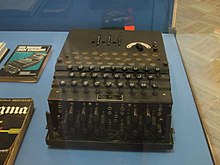Enigma equation

The Enigma equation describes the permutation (exchange of letters) that occurs during encryption with the help of the rotor key machine Enigma . It was set up by the Polish code breaker Marian Rejewski during his work in the Biuro Szyfrów (German: "Chiffrenbüro") in Warsaw and formed the basis for determining the roller wiring of the German machine. With this, Rejewski created the decisive prerequisites for deciphering the Enigma in World War II .
meaning
The equation is as follows (where stands for the composition of two figures):
- .
It describes the relationship between
- a plaintext letter ( p for plaintext ; German: " Klartext ") and
- the corresponding ciphertext letter ( c for ciphertext ; German: " ciphertext ")
as well as the cryptographic elements of the machine that effect the permutation and thus the encryption , namely
- the "plug board", which causes an involutive substitution T ,
- the set of rollers, which consists of (mostly three) rotating rollers that create a polyalphabetic substitution , and
- the fixed reversing roller (VHF), which generates another involutive permutation U.
Since the electrical current flowing through the machine, after passing the VHF, runs through the set of rollers again, now in the opposite direction, and finally flows through the plug board again, the two terms and appear again in inverted form at the end of the Enigma equation .
Because of the involutorics (encryption = decryption), the Enigma equation applies to decryption as well as for the encryption process .
history
The equation was drawn up by the then 27-year-old Polish cryptanalyst Marian Rejewski while working in the Polish decryption center, the Biuro Szyfrów, in 1932 and formed the basis for determining the roller wiring of the three rollers, which was kept top secret by the German military (at that time) I to III and the reversing roller A of the Enigma. With this, Rejewski laid the decisive prerequisites for deciphering the secret military communications of the German Wehrmacht during World War II.
The American historian David Kahn praised this as a masterpiece of cryptanalysis which Rejewski " elevates into the pantheon of the greatest cryptanalysts of all time" (in the original: "elevates him to the pantheon of the greatest cryptanalysts of all time" ). The British code breaker Irving J. Good designated Rejewskis equation as "The theorem did won World War II" (German: "The theorem that won World War II").
literature
- Friedrich L. Bauer : Deciphered Secrets. Methods and maxims of cryptology. 3rd, revised and expanded edition. Springer, Berlin et al. 2000, ISBN 3-540-67931-6 .
- Philip Marks , Frode Weierud : Recovering the wiring of Enigma's reverse roller A . PDF; 0.2 MB . Retrieved February 16, 2016.
- Kris Gaj, Arkadiusz Orłowski: Facts and myths of Enigma: breaking stereotypes. Eurocrypt, 2003, pp. 106-122. PDF; 0.1 MB
- Michael Pröse: Encryption machines and deciphering devices in World War II - history of technology and aspects of IT history . Dissertation, Leipzig, 2004, p. 97 PDF; 7.9 MB
- Marian Rejewski : An Application of the Theory of Permutations in Breaking the Enigma Cipher . Applicationes Mathematicae, 16 (4), 1980, pp. 543-559 PDF; 1.7 MB .








